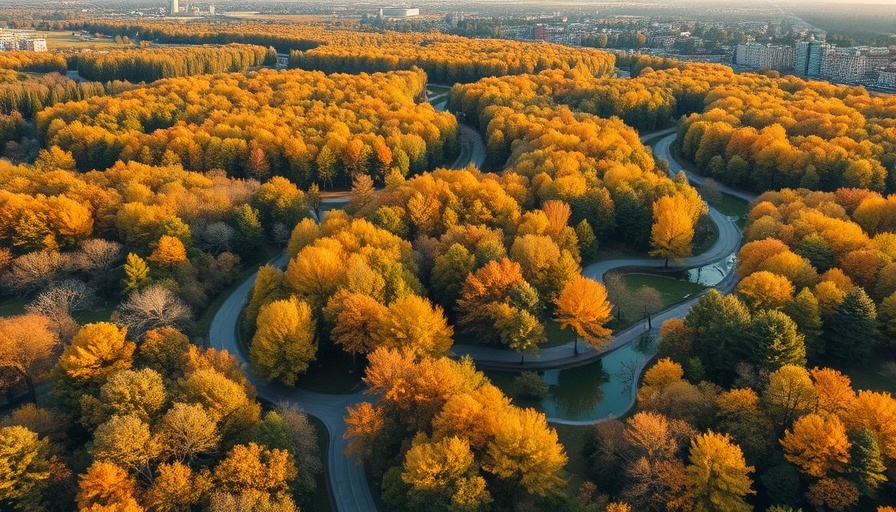
Reviving Urban Green Spaces: Forest Park's Inspirational Journey
In a world increasingly dominated by concrete and steel, the restoration of Forest Park in St. Louis, Missouri, stands out as a remarkable example of urban revitalization. Recently honored with the ASLA 2025 Landmark Award, this stunning transformation not only pays homage to its rich historical roots but also offers a modern approach to landscape architecture, ensuring the park remains a viable public space for generations to come.
A Historical Treasure Reimagined
Established in the backdrop of the 1904 World’s Fair, Forest Park spans a sprawling 1,370 acres, making it one of the largest urban parks in the United States. However, by the late 20th century—particularly during the 1970s and 80s—the park faced significant challenges. With dwindling funding and maintenance, its once-captivating allure faded, leading to safety concerns and decreased accessibility for the community.
The nonprofit conservancy Forest Park Forever (FPF) took pivotal action in 2000, enlisting the expertise of HOK, a leading landscape architecture firm, to restore the park’s most iconic features in anticipation of the 100th anniversary of the World’s Fair. This collaboration emphasized a balanced integration of historical integrity with contemporary environmental demands.
Modern Amenities and Eco-Friendly Design
Brian Jencek, Director of Planning at HOK, elaborated on their holistic approach. “By restoring ecosystems, improving access, and creating inclusive spaces,” he stated, “we’ve prepared the park to serve its community and future generations.” The upgraded amenities reflect a strong commitment to sustainability, embracing not just aesthetic improvements but also ecological stewardship.
With more than 15 million visitors annually, the park has transformed into a bustling hub of recreation, culture, and civic engagement. It has earned the title of the best city park in USA Today’s readers’ choice awards for two consecutive years, solidifying its status as a national destination.
The Heart of the Community
The success of Forest Park is not merely in its accolades but in its profound connection to the St. Louis community. As Lesley Hoffarth, the President and Executive Director of Forest Park Forever, aptly put, “These signature projects remain wonderful examples of landscape architecture for the entire St. Louis region to enjoy.” The park's restoration not only enhances its aesthetic appeal but also reinforces community ties, hosting everything from sports activities to cultural events, making it a cornerstone of civic pride.
Lessons for Landscape Professionals and Communities
Landscape contractors, designers, and developers can draw significant insights from Forest Park’s revitalization. Creating a successful urban green space hinges on a few key strategies:
- Engagement and Collaboration: Involving community stakeholders and organizations fosters commitment and support, ensuring the project addresses local needs.
- Sustainable Practices: Integrating eco-friendly design elements promotes biodiversity and resilience, essential for long-term viability.
- Adaptive Design: Balancing historical integrity with modern amenities attracts diverse visitors and enhances overall functionality.
By reflecting on these aspects, landscapers and urban planners can push the envelope on how they develop their communities, ensuring that every green space is both beautiful and functional.
Fostering Future Green Spaces
The achievements of Forest Park serve as a blueprint for future urban projects. As communities nationwide grapple with the challenges of urbanization, the insistence on creating vibrant, accessible public spaces remains vital. Adopting the principles of restoration seen at Forest Park will not only beautify neighborhoods but also provide essential green space that fosters community engagement and well-being.
As landscaping professionals in Muskegon, Michigan, contemplate their next projects, consider the lessons from Forest Park. Whether you specialize in outdoor landscaping crews, residential turf care, or yard beautification services, the principles of sustainable practices and community involvement pave the way for success. Embrace the opportunity in each project to contribute positively to your community’s outdoor spaces.
Conclusion: Transforming Our Landscapes
The story of Forest Park is not just about restoring a park; it resonates with the larger narrative of improving our urban environments to cater to future generations. As we work on our landscaping duties, let’s remember that each effort contributes to a larger legacy. Together, we can transform our communities and create beautiful, sustainable green spaces that everyone can enjoy.
 Add Row
Add Row 
 Add
Add 


Write A Comment